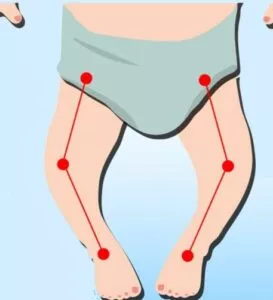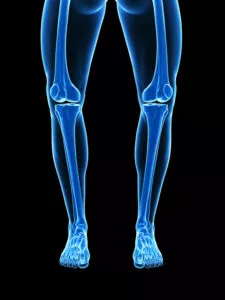
Bow Legs
Bow Legs occur when one or both of your child’s legs curve outward at the knees. This opens up the space between the knees and lower legs more than usual. Also, the knees remain wide apart when your child stands with his or her feet and ankles together.
If your child needs surgery or casting, our Fracture Care Clinic opens every day and you do not need an appointment. Surgery rooms get scheduled every morning, so your child receives the care and attention they need right away.
Bow Legs
When children have bow legs, their legs seem to bow or bend outward, sometimes called Bowed Legs. Furthermore, doctors can see this condition when a baby or person has a space between their knees while standing straight or laying down with their feet and ankles touching each other. Newborns normally have bow legs when they are born that will usually go away before the age of two. As doctors, we see bow legs often and as we monitor the youngsters they gradually display indications of correction as they become older. After the age of two, bow legs in children can indicate an underlying medical issue like rickets or Blount’s disease. Bow legs in adolescents are frequently the result of being overweight or obese.
What Does Bow Legs Look Like?
A condition known as bow legs (genu varum) occurs when one or both of your child’s legs curve outward at the knees. As such, this opens up the space between the knees and lower legs more than usual. The knees remain wide apart when your child stands with his or her feet and ankles together. When your child walks, the bow may become exaggerated.
Who gets Bow Legs?
Bow legs are typically seen in young children. Bow-legged newborns often outgrow the deformity around 18 months of age. Older kids may also have bow legs. To ensure that a more severe condition does not exist, we recommend parents bring their children to us for an examination.
 What Causes Bowed Legs?
What Causes Bowed Legs?
Bow legs can form for a variety of reasons. For instance, a condition known as physiologic genu varum is the most common cause of bow legs. Physiologic genu varum is simply your child’s normal developmental process. If your child’s legs haven’t straightened around the age of two, an underlying medical condition could cause the problem. These are some examples:
- Blount disease is a growth disorder caused by a problem in your child’s shin bone’s growth plate. Blount’s disease is more common in African American children, overweight children, and children who began walking at a young age.
- Rickets is a deficit in calcium or vitamin D is the root cause of this illness. Deficiencies in these essential nutrients soften and weaken your child’s bones, causing his or her legs to bow.
- The most commonly cited reason for dwarfism is achondroplasia. This condition can result in bow legs.
- Bow legs can result from aberrant bone development and inadequately healed fractures (bone dysplasia).
- Lead or fluoride poisoning.
How do Children’s Legs and Knees Develop?
Bowlegs in infants: Bow-leggedness is normal between the ages of one and 24 months.
Toddlers: Toddlers’ legs align between the ages of 24 and 36 months.
Young children: Between the ages of 3 and 5, children may develop knock knees, a condition in which the knees bend inward.
Children’s legs continue to straighten as they grow. Around the ages of 7 to 8, or possibly closer to the adolescent years, children’s walking patterns usually become normal or almost normal.
What are the Symptoms?
The appearance of your child’s legs is the most obvious sign of bowed legs. When they stand with their feet and ankles together, their knees will not touch. The bowing is most noticeable when they are walking. Children may occasionally walk with their toes pointing inward (pigeon toes or intoning). Bow legs, on the other hand, rarely cause pain. Bow legs have little impact on your child’s ability to crawl, walk, or run. When your child is two years old, if their bow legs have not improved, please make an appointment with us to have your child examined.
When Should Parents Worry about Bow Legs?

If your child has bowlegs as well as any of the following symptoms, a more serious condition may exist.
- Bowlegs that get worse after the age of two.
- The bowing’s asymmetric appearance.
- Walking with a limp.
- Hip or knee pain.
- Petite stature (below the fifth percentile).
Please contact us and make an appointment if your child exhibits any of the above symptoms.
How are Bow Legs Identified?
One of our specialists will perform a physical exam and inquire about his or her medical history. However, if your child is under the age of two, doctors normally will not request additional tests. Rather, we will want to keep an eye on the bowing and ensure that it resolves on its own as your child grows. If your child is over the age of two, our doctors may measure his or her legs and observe him or her walking. We may order imaging tests like X-rays to look at the bones in your child’s legs and knees. To determine whether a disorder like rickets is the source of the bow legs, we may request blood testing. We are pediatric orthopedic specialists; so rest assured we know kids and you will get the very best of care for your child.
Can Doctors Correct Bow Legs?
Bow legs in infants and toddlers under the age of two usually go away on their own. As experts in this field, we will continue to monitor his or her condition. Depending on the cause of the condition, we treat older children and adolescents.
How are Other Bowleg-Related Conditions Treated?
Blount’s disease is typically treated with a combination of non-surgical and surgical measures, including the use of a special brace. Doctors recommend that the brace, known as a modified knee-ankle-foot orthosis (KAFO), be worn 24 hours a day, seven days a week (23 hours a day). This relieves compression in the knee area, allowing your child’s legs to grow normally. If the brace alone corrects the problem in young children with Blount’s disease, surgery is not necessary. Doctors prescribe Vitamin D and calcium supplements to treat rickets in children. Children with rickets are typically referred to an endocrinologist for assistance with their medical management.
How are Babies with Bow Legs Corrected?
Unless the condition is severe, babies and toddlers do not require treatment. After age two, if bow legs still exist, the underlying reason will dictate the appropriate course of action. braces, surgery, or treatment of the underlying condition may follow.
- Blount’s disease. Early intervention with a splint or leg brace may often solve the problem.
- Ricket’s disease. In coordination with your pediatrician, we may prescribe calcium and vitamin D supplements to help manage your child’s condition. If your child’s rickets is caused by a genetic condition, we may refer you to a specialist for treatment.
If the bowing persists despite treatment, the doctors may recommend surgery to prevent further damage and correct the problem. Among the surgical options are:
- Guided development. In this procedure, we will insert a small metal plate or staple into his or her leg. This will halt growth on the healthy side of the shin bone for a short time, allowing the unhealthy side to catch up. Your child’s leg will straighten with natural growth, and the plate or staple gets removed once alignment has improved.
- Tibia osteotomy. We will make an incision and reshapes the shin bone below the knee to fix the alignment. While the bone heals, it is held in place with a plate and screws inside the leg or an outside-the-leg frame.
Do Bow Legs Correct Naturally?
As previously stated, yes. However, the reason for bow legs affects how the problem is treated. Doctors sometimes consider braces as early treatment options.
How Can I Prevent My Baby from Developing Bow Legs?
There is no remedy to avoid your baby from developing bowed legs. However, parents can avoid certain conditions that cause bowed legs. Make sure your child gets enough vitamin D and calcium in their diet to avoid rickets.
How Much Time Does It Take for Baby’s Legs to Straighten?
As your baby begins to walk, their legs should begin to straighten. This is most common between the ages of 11 and 18 months. In most cases, the condition is not serious, and there are no long-term consequences. When your child is two years old, if their legs haven’t already straightened, please call and make an appointment with us
At What Point Should Parents Get Concerned About a Baby’s Bow Legs?
When your infant is two years old and still has bow legs, call us for an appointment. We will perform a physical exam, look for underlying conditions, and recommend the best treatment.
What is the Future of Bow Legs?
Bow legs are typically outgrown by the age of two in babies and toddlers. Therefore, they should have no difficulty walking, running, or participating in any activity they desire. Furthermore, after treatment, children with bow legs can lead normal, active lives. Most children with bowlegs grow out of the condition and can walk, run, and play normally. Also, treatment is frequently required for severe bowlegs or bowlegs caused by an underlying condition. Severe bowlegs, on the other hand, can result in leg deformity, difficulty walking or running, and an increased risk of arthritis later in life.
Observation of Bowed Legs
Finally, it’s usually not a cause for concern if your baby has bow legs. Furthermore, most babies and toddlers grow out of the condition without needing treatment. As your kid grows, our doctors will continue to keep an eye on his or her condition. If your child does not outgrow the condition by the age of two, your child’s doctor will discuss treatment options with you. In conclusion, call us and make an appointment to ensure that your child outgrows the condition and goes on to live a normal and healthy life.
Bowed Legs in children are a significant concern that requires early recognition and appropriate management. Understanding the causes, symptoms, diagnosis, and treatment options is crucial for healthcare professionals, parents, and caregivers. By promoting early intervention, following effective treatment strategies, and providing comprehensive rehabilitation, the long-term outcomes for children with this condition allow tends to be fantastic.
It is important to note that this document serves as an informational guide and should not replace professional medical advice. If you suspect that a child may Bowed Legs or any other medical condition, it is recommended that you give us a call and schedule an appointment at one of our three offices – Arlington, Dallas, Flower Mound, Frisco, and McKinney, Texas. At the Medical City Children’s and Spine Specialists Medical Practice, our doctors specialize in kids and treat those with Bow Legs.
____________________
Footnote:
Call 214-556-0590 to make an appointment.
Comprehensive services for children from birth through adolescence at four convenient locations: Arlington, Dallas, Flower Mound, Frisco and McKinney.
